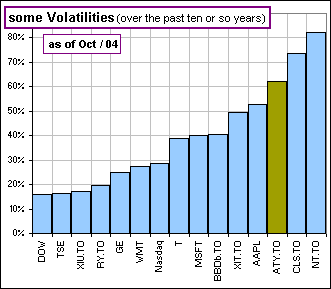| Returns and Volatility |
In a Morningstar post Taylor Larimore noted that:
An ounce of higher return is worth more than a pound of lower volatility.That's such a slick observation I couldn't help myself so I ...
>You wanted to illustrate it, right?
Well ... uh, yes, to illustrate that changes in Average Return are more significant than changes in Volatility.
(from 5% to 7%, without changing the Volatility of 24%)
and note that the Annualized Return increases by 2% as well
... very nearly

On the other hand ...
(from 35% to 30%, without changing the Average Return of 11%)
and note that the Annualized Return increases by just 1.6%
... very nearly

In fact, if the Volatility is v%, we can expect the change in Annualized Return to be roughly v% of the change in Volatility.
>Huh?
In the above example, the Volatility is roughly v% = 32.5%
... changing, as it does, from 35% to 30%.
Hence we can expect the change in Annualized Return to be roughly 32.5%
of the 5% change in Volatilty
... and that means 32.5% x 5%
or roughly 1.6%
... as indicated in the chart
>I assume you can prove all this, eh?
That the Annualized Return increase is roughly equal to the Average Return increase?
And that it's just a percentage of the Volatility increase - the percentage being roughly v%?
Yes, I can prove it. Would you like to see the proof?
>Certainly not! Besides, why all those roughly thingys ?
Nothing is precise in the shadowy world of finance.
Indeed, I assumed that the Annualized Return is related to the Average Return and Volatility according to:
Annualized Return = Average Return - (1/2) Volatility2
Note that (as Tom C. points out):
"Given two assets with the same average return, the asset with the lower volatility will result in a higher annualized return."
See CAGR
>I assume that's roughly true?
You got it 
Here are a few Volatilities
obtained by looking at the Standard Deviation of monthly returns
... then multiplying by SQRT(12)

... and some Vanguard Mutual Funds

